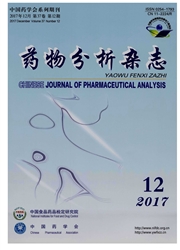

 中文摘要:
中文摘要:
目的:建立一种适用于阿司匹林稳定性及其降解动力学研究含量测定的反相高效液相色谱法。方法:Shimadzu ODS柱(250mm×4.6mm,5μm),以乙腈为溶剂,流动相为甲醇-水-冰醋酸(40:60:6,盐酸调节pH为2.5),检测波长280nm,柱温40℃,流速为1.0mL·min^-1。采用导数色谱法鉴定了色谱峰纯度。结果:在选定色谱条件下,阿司匹林能与相邻杂质完全分离。阿司匹林在60~1800μg·mL^-1范围内,峰面积与浓度线性关系良好(r=0.9998);平均回收率为100.6%,RSD为1.3%,重复性试验RSD为0.9%(n=5)。高、中、低3个浓度的精密度试验RSD均小于1.4%(n=5)。化学动力学研究表明,阿司匹林的降解过程由活性反应中心的增长来控制,遵从Prout—Tompkins模型。结论:该方法快速简便,结果准确可靠,可作为阿司匹林稳定性及降解动力学研究的含量测定方法。
 英文摘要:
英文摘要:
Objective: To establish a RP - HPLC method applicable to the analysis of aspirin in the presence of its degradants. Methods: Peak homogeneity of the resolving drug peak was assessed by the shape of the derivative spectroscopy. In the method, Shimadzu ODS column (250 mm ×4.6mm,5μm) was used. The mobile phase was methanol- water- acetic acid(40: 60: 6,adjust to pH 2.5) with the flow rate of 1.0 mL · min^-1. The UV dectection wavelength was 280 nm. Results: The calibration curve was linear in the range of 60 - 1800 μg ·mL^-1 (r = 0. 9998). The average recovery was 100. 6% with RSD 1.3%. The method precision was 〈 1.4% (n =5). Our experiments showed that the degradation of aspirin at constant humidity and temperature obeyed Prout - Tompkins nucleation model with an initial induction period and acceleratory period. Conclusion:The method is selective, simple and accurate, and is applicable to the analysis of aspirin in the presence of its degradants.
 同期刊论文项目
同期刊论文项目
 同项目期刊论文
同项目期刊论文
 期刊信息
期刊信息
